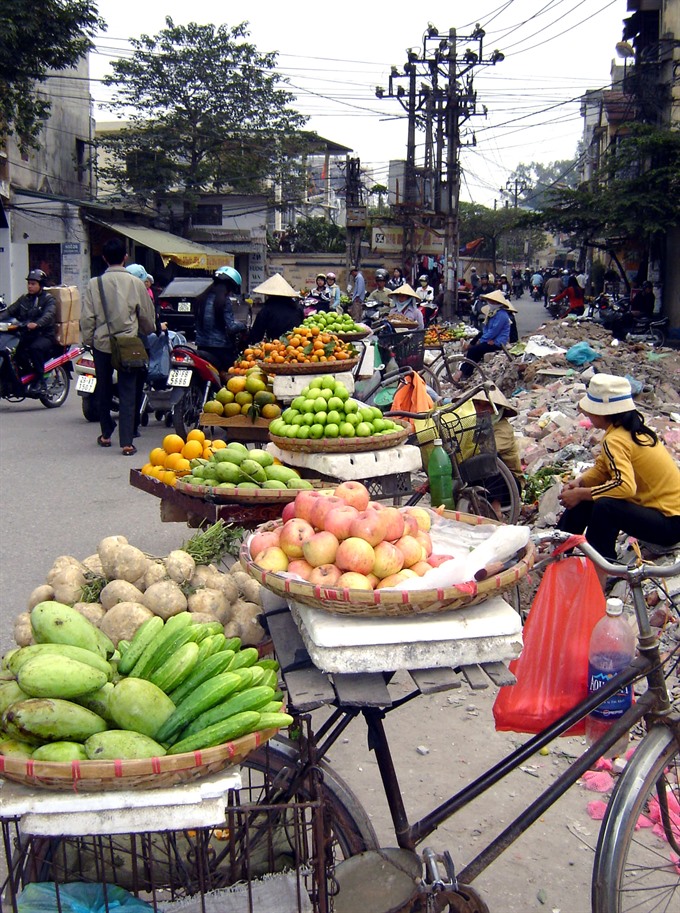 Society
Society

Ambitious plans to establish designated areas for street vendors in both Hà Nội and HCM City are still unable to materialise, a few months after a resounding “sidewalk clean-up” campaign fuelled debates over future of the uncountable street vendors.
 |
| Street vendors sell fruits and vegetables at a ’makeshift’ market on Đông Tác Street, Đống Đa District. — VNA/VNS Photo Bùi Tường |
HÀ NỘI — Ambitious plans to establish designated areas for street vendors in Hà Nội and HCM City have yet to materialise, months after a “sidewalk clean-up” campaign fuelled debates over the future of street vendors.
In HCM City, after the clean up campaign reached its peak in February and March this year, authorities in some districts eagerly put forward plans for ‘vendor streets’ where street vendors could do business in an orderly manner.
A proposal submitted to the city’s People’s Committee by District 1 designated the sidewalks of Nguyễn Văn Chiêm and Chu Mạnh Trinh streets and Bách Tùng Diệp Park for this purpose. These places are said to have spacious pavements with room for both vendors’ businesses and vehicle parking.
Stools, tables and umbrellas for street restaurants would also be provided to avoid obstructing pedestrians, according to the proposal.
In a meeting with city leaders on March 20, Chairman of District 1 People’s Committee expressed his high hopes for the plan as a solution to restore public order on pavements and ensure the livelihoods of poor labourers.
District 3 also planned to designate Lê Ngô Cát, Ngô Thời Nhiệm and Hồ Xuân Hương streets as walking streets and places open for vendor activity in specific hours.
However, nearly four months later, no such vendor street exists.
Speaking to the Thanh Niên (Youth) newspaper, a street-food vendor in Bách Tùng Diệp Park in District 1 said: “I only heard about the plan through the media. We haven’t been informed by authorities.”
According to the Economic Affairs Division of District 1’s People’s Committee, vendor streets were initially planned to be launched in the second quarter of this year. However, thus far, it is unclear when these streets will open.
Explaining the delay, Đoàn Ngọc Hải, vice chairman of the district People’s Committee told the Thanh Niên that because the designated areas are in the city centre, the organisation needs to prepare thoroughly and collect opinions from various bodies.
Meanwhile, Vice Chairman of District 3’s People’s Committee Trần Thanh Bình said the district’s initial plan failed as local residents opposed it.
Most residents in the designated areas feared that vendor activity would adversely impact their life, he said.
As a result, the district had to move the plan to an area around Con Rùa Lake and is still collecting public opinions on the change of location.
Similar plans in District 4 and District 10 suffered the same fate.
A plan to use the sidewalks of Lý Thường Kiệt and Tô Hiến Thành streets in District 4 still only exists on paper.
Trần Hoàng Quân, chairman of District 10’s People’s Committee said a plan to use a 2,000sq.m land lot for 150 household vendors was only agreed to by 60 of the households, while the organisation work is still unfinished.
Chilly reactions
Hà Nội authorities, meanwhile, have been trying to move street vendors to local markets. But this plan also seems unfeasible.
Since 2016, the municipal People’s Committee has asked district authorities to eradicate unplanned markets and set up new markets for street vendors in appropriate places.
But across the city, street vendors riding bikes or carrying baskets filled with all types of products are still a common sight.
Hà Anh Tuấn, head of Urban Management Division of Đống Đa District, said the district has no spare space to build new markets while existing ones are full and cannot accommodate street vendors.
Meanwhile, local authorities that can carry out the plan were met with chilly reactions from street vendors.
Lê Thị Hương, a street vendor in Tràng Thi Street said she was not willing to move to a market as she will have to pay a monthly fee and she feared her sales would suffer in a new location.
Like Hương, many street vendors believe that if they move to a market, it will be difficult to compete with traders with established businesses in the market.
In fact, since April, the People’s Committee of Thanh Xuân District has provided more than 100sq.m in Thanh Xuân Bắc market for street vendors, prioritising those who were forced from the street during the sidewalk campaigns. They were also offered three months free of fee. However, few vendors were willing to relocate.
City-dwellers who prefer hitting the pavement for everything from a bundle of vegetables to a bowl of noodles also helps nourish the street-vendor culture, as it is quicker and more convenient.
“Going to a market requires people to park their vehicles, which costs money and is time-consuming. This is one thing that makes consumers opt street vendors,” said Dương Việt Hùng, head of the Economic Affairs Division of Tây Hồ District.
To tackle the problem, in implementing a plan to resettle street vendors to Xuân La market in 2018, Tây Hồ District authority will offer preferential policies for street vendors to relocate and set up a spacious parking space free of charge in the market, Hùng said. — VNS



.jpg)
